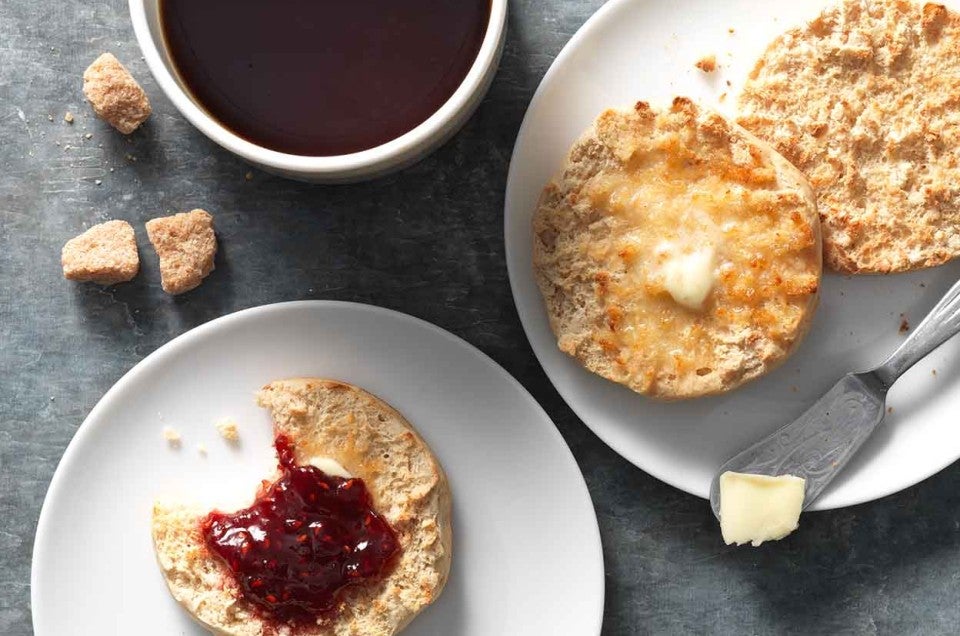


Do you want to know how to make ridiculously decadent and delicious eggs Benedict, start(er) to finish?
Read on.
Eggs Benedict, for any of you unfamiliar with this fancy breakfast favorite, is an English muffin half, toasted and topped with a slice of ham, a poached egg, and hollandaise – a rich butter/egg/lemon sauce.
Now, that's the classic version. But go to any restaurant higher up the dollar scale than, say, Mickey D's, and you'll find eggs Benedict in a surprising number of incarnations.
The traditional slice of ham can give way to Canadian bacon, smoked salmon, corned beef hash, or asparagus (for a vegetarian take). The egg might be fried, or even scrambled; the sauce often morphs into cheese sauce.
But every version starts on an English muffin. Which is what we're going to make today.
Really? When it's so easy to buy good English muffins?
Yes, really. Because A) Making English muffins isn't nearly as challenging as you might think; B) Homemade English muffins are DA BOMB; and C) Sourdough English Muffins aren't generally available at your local supermarket.
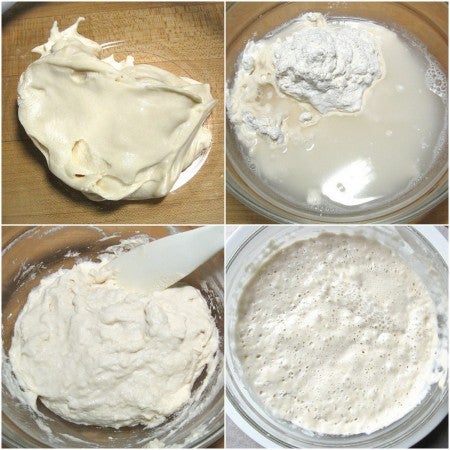
While this recipe doesn't require your sourdough starter to be fed, I like the vigor of a fed starter; it helps the muffins rise.
Beginning with 4 ounces of dormant starter, I add 4 ounces each King Arthur Unbleached All-Purpose Flour (scant cup) and lukewarm water (1/2 cup), stirring to combine.
Depending on how dormant my starter is, it will begin to bubble vigorously within several hours; or it will take a few days of feeding to get it going. Your goal is a happily bubbling starter (bottom right).
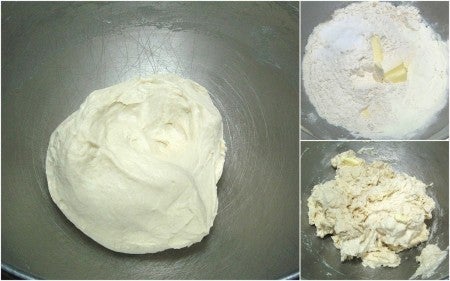
Combine the following ingredients in a large bowl:
2 tablespoons sugar
2 cups warm water (110°F-115°F)
1 tablespoon active dry yeast or instant yeast
1 cup sourdough starter, fed or unfed; fed will give you a more vigorous rise
7 cups King Arthur Unbleached All-Purpose Flour
1/2 cup Baker's Special Dry Milk or nonfat dry milk
1/4 cup (4 tablespoons) butter, at room temperature
1 tablespoon salt
1/4 teaspoon sour salt (citric acid), optional; for enhanced sour flavor
Mix and knead — by hand or electric mixer — to form a smooth dough. The dough should be soft and elastic, but not particularly sticky; add additional flour if necessary.
Want to use your bread machine to mix and knead the dough? Go for it. You'll want to let it rise in a larger container, though.
By the way, if you don't want to make 2 dozen muffins, this recipe is easily halved. Simply halve all of the ingredients; for a slightly faster rise, reduce the yeast to 2 teaspoons, rather than 1 1/2 teaspoons.
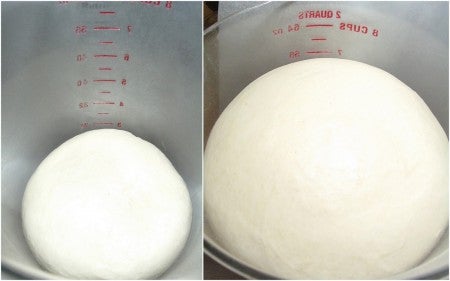
Place the dough in a lightly greased bowl, or an 8-cup measure, as I've done here. Cover the container.
For most pronounced sour flavor, immediately place the dough in the refrigerator. Let it chill for 24 hours; the dough will rise, and the long rest will develop its flavor.
If you're in a hurry, or don't particularly care about strong sourdough flavor, don't chill the dough. Simply set it aside to rise at room temperature for about 1 1/2 hours, or until it's noticeably puffy.
An advantage of using the measuring cup is that I can quickly see just how much the dough has risen. It's more than doubled in bulk - going from 3 to 7 cups.
Gently deflate the dough, and turn it out onto a lightly floured or lightly greased work surface.
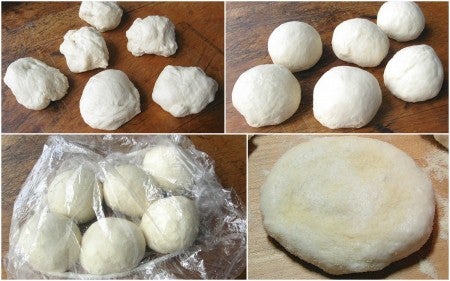
Divide the dough into 24 pieces. Shape each piece into a round ball. Let the balls rest for 10 minutes, to relax their gluten.
Flatten each ball into a 3" round.
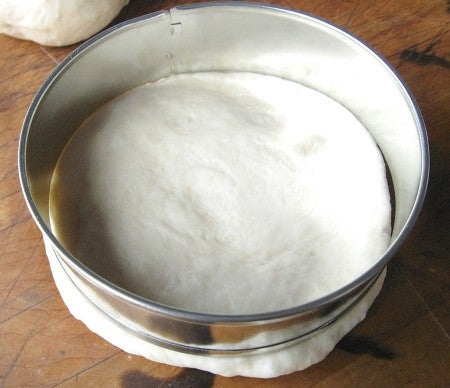
For a somewhat more even rise as the muffins cook, flatten each ball slightly larger than 3", and trim edges with a 3" cutter (or trim all around the edge with a pair of scissors).
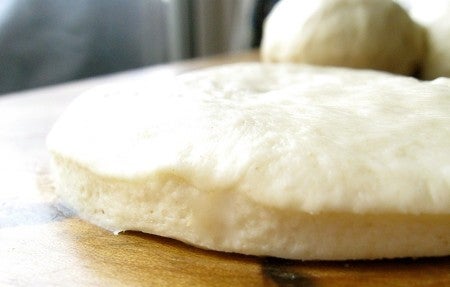
Muffins with cut (rather than flattened) sides will rise more evenly.
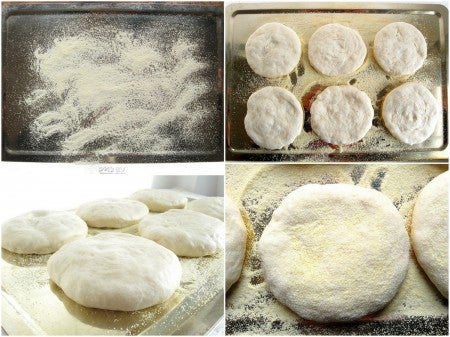
Place the rounds, evenly spaced, onto cornmeal- or semolina-sprinkled baking sheets. Cover with plastic wrap, and let them rise until light and puffy, about 45 to 60 minutes. Sprinkle with additional cornmeal or semolina.
If the dough has been refrigerated overnight, the rise time will be about 2 hours.
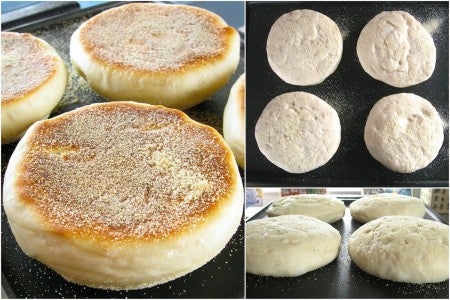
Carefully transfer the rounds (as many as a time that will fit without crowding) to a large electric griddle preheated to 350°F, or to an ungreased frying pan or griddle that's been preheated over medium-low heat.
Cook the muffins for about 10 to 12 minutes on each side, or until an instant-read thermometer inserted in the center of a muffin registers 190°F. The edges may feel a bit soft; that's OK.
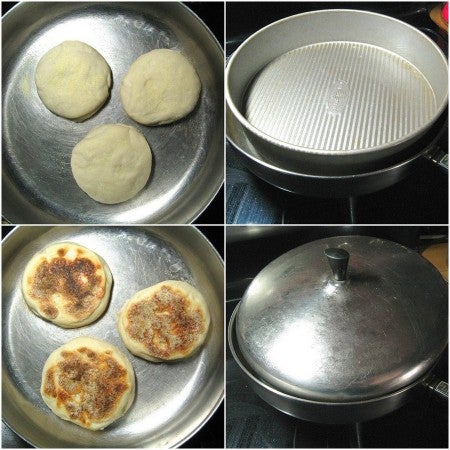
To shorten cooking time, instead of an open griddle use a lidded electric fry pan heated to 325°F.
For best shape, cook the muffins for about 5 minutes on their first side. Then lay a cake pan, cookie sheet, or similar flat (though not overly heavy) object atop them; this helps keep muffins flat across the top (rather than domed).
Continue cooking for 7 minutes or so; then remove the pan, and turn the muffins over. Place the lid on the pan, but don't set it on tight; leave a small opening for any steam to escape. Cook the muffins for an additional 8 to 10 minutes, until their bottom sides are browned.
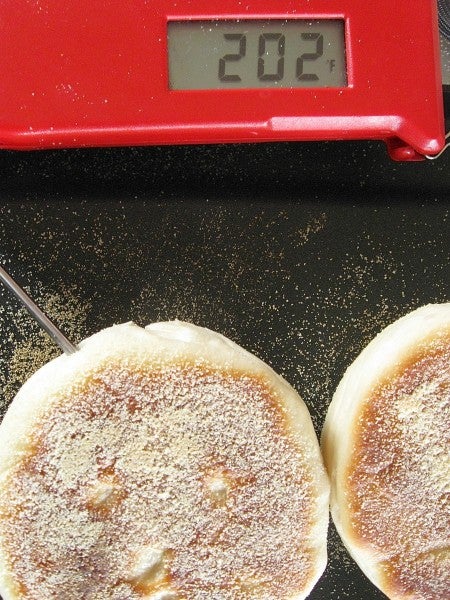
I guess these are done. LOVE my digital thermometer... it really takes the guesswork out of so many baking projects.
Remove the muffins from the griddle, and cool on a rack.
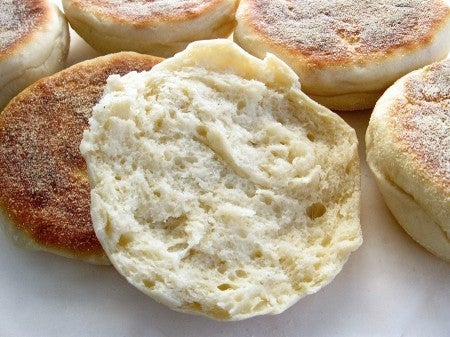
Don't split until they're completely cool! Pretty nice nooks and crannies, eh?
Now, on to the eggs Benedict.
A classic serving of eggs Benedict includes two English muffin halves, with toppings. I prefer to eat just one.
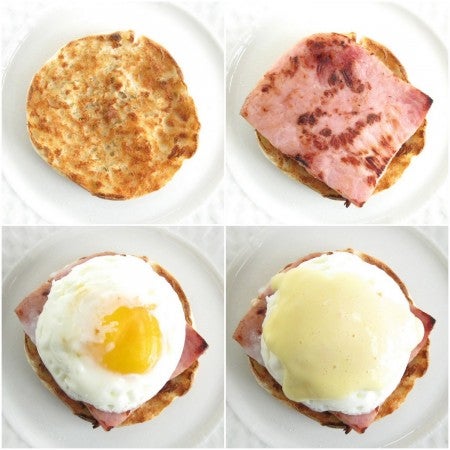
Toast an English muffin half; butter it, if you want to totally gild the lily.
Top with a thick slice of warmed or fried ham.
Top with a poached egg. If you don't like poaching eggs, fry it; or scramble it, even. Poached is classic, but there's no need to stand on ceremony here.
Top with hollandaise sauce.
Now, I'm sure many of you use hollandaise sauce mix. But it's really quite easy to make it from scratch, especially if you have a blender, or small food processor with an opening in the top to add ingredients on the fly.
The following amount of ingredients makes enough hollandaise for 4 generous servings.
Place 2 large egg yolks, 2 to 3 teaspoons lemon juice (to taste), 1/8 teaspoon salt, and a dash of Tabasco into a small blender or food processor.
Heat 1/2 cup (8 tablespoons) butter until very hot, either in a saucepan, or the microwave. The butter should be sizzling/popping hot, not just melted.
With the motor running, pour the butter gradually over the egg yolks/lemon juice, blending/processing until the sauce is thick.
If, for whatever reason, the sauce doesn't thicken for you, transfer it to a small saucepan, and cook over low heat, stirring constantly, until it becomes thick.

This sauce isn't quite as thick as I like it; I was in a hurry, and didn't heat the butter hot enough.
Still, I had no trouble finishing off this decadent dish, once I'd taken the photo.
Just to make doubly sure of the picture, however, I made another one – and my husband enjoyed an unexpectedly tasty breakfast, too!
Please read, make, and review our recipe for Sourdough English Muffins.